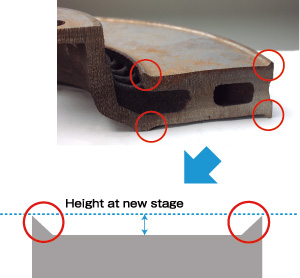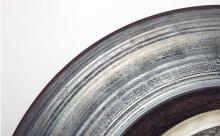Technical Articles
Brake Literature
Case study 1 on brake squeal
 Case1
Case1
Continue to utilise used disc, replaced only new pad. Right after the replacement the squeal start. Since pad replaced, the cause must be on the pad. However there is no abnormality shown on the pad. Inspected for various possible causes, not fully understood.
While careful inspection of disc, the disc edge (area circulated by red ink) sharply pointed is noticed.
Case2
Continued to utilise used disc, replaced only new pad. Right after the replacement the squeal start. Since pad replaced, the cause must be on the pad. However there is no abnormality shown on the pad. Inspected for various possible causes, not fully understood.
While there is no abnormality shown on the pad, surface of the disc has friction material left over and deposit from previously used pad, and further, steps created.

Conclusion
Firstly, in the case 1, since the new pad applied naturally the friction surface being fully flat. Then combined with used disc having sharply pointed edge (area circulated in red ink) alone touch against and rubbed as scratched by nail, start squeal. Only the very small portion of disc touched and cautious for very poor effect.
Next, in the case 2, while friction material adhered to disc surface, such area alone exclusively dragged and cause squeal. Or, there are steps, pad and disc will not adhere tightly and vibration appeared to create squeal.
Further, both in the case 1 and case 2, not only the pad replacement, grinding of disc or replacement to new disc virtually stop the squeal.
Hearing “since the parts replaced being pad alone, cause must be in pad?” Or, “No squeal appeared before, therefore, there is no other cause than pad” In these cases, possibility by pad is very low. Naturally, no squeal heard from long used pad and disc, However, it was based on fitting at uneven area like cogwheel, now pad without such uneven area combined —. Simply imagined.

